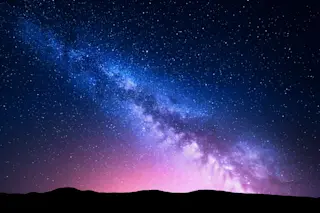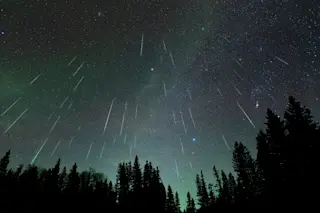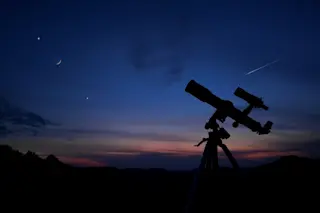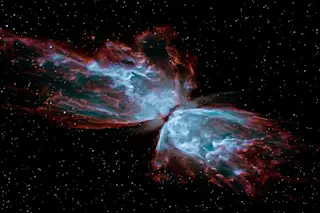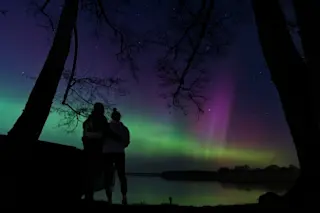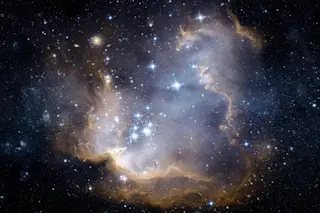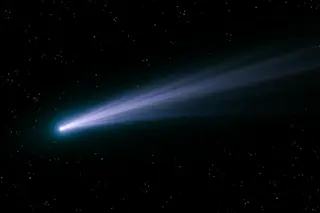Every few months, like clockwork, someone sends me an email telling me about a lovely picture they’ve seen. This photo, it’s claimed, shows a sunset at the north pole with the crescent Moon looming hugely over the horizon. Perhaps you’ve seen it via email or a social network; the picture really is stunning, as you can see for yourself:
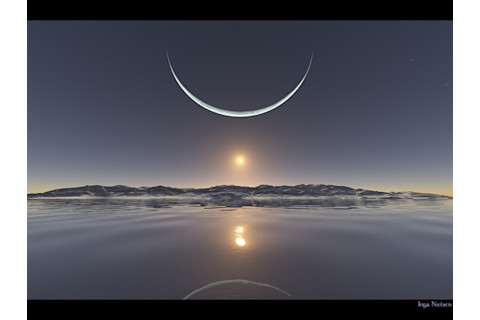
nielsen_sunsetnorthpole
It is pretty, isn’t it? But it has one teeny tiny problem: It’s not a photograph! It’s a drawing, called “Hideaway”, created by Inga Nielsen. It’s a really, really gooddrawing, beautifully done, so realistic it can fool people into thinking it’s a photo. I’ve seen people thinking so on bulletin boards for years, and in fact it just popped up again, this time on Google+. And, as usual, a lot of folks thought it was real.
I can’t blame them, since it’s photo-realistic, as many digital drawings are these days. And if you see this without attribution to the artist, and don’t know the astronomy behind the scene, it’s hard to say whether it’s real or not.
So how can I tell it’s a drawing? Ah. Glad you asked.
Size does matter
Right away, the size of the Moon in the picture compared to the size of the Sun is a dead giveaway this isn’t a real photograph. In the real sky, the Moon and Sun appear to be the same size.
The angular size of an object — that is, how big it looks in the sky — depends on its physical size and its distance. Things look bigger the closer they are, and if two objects are at the same distance, the physically bigger one will look bigger. There’s some simple math that governs this: the angular size of an object is actually its diameter divided by its distance†. So let’s do the math for the Sun and Moon:
Moon size / Moon distance = 3474 km / 384,000 km = 0.00905
Sun size / Sun distance = 1.4 million km / 150 million km = 0.0093
As you can see, the two ratios are almost exactly the same! The Sun is about 400 times bigger than the Moon, but it’s also 400 times farther away. Because of that, they appear to be the same size to our eye.
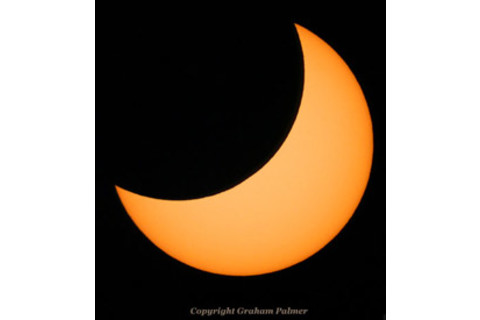
palmer_partialsolareclipse
But in the original picture, the Moon is about 20x bigger than the Sun! So again, right away we know this image must not be real.
In fact, the Moon and Sun being the same apparent size is why we can have such beautiful solar eclipses. If the Moon were so much larger than the Sun as depicted in the drawing, we’d never see the Sun’s ghostly corona during an eclipse; the huge Moon would block it completely. And when you look at partial solar eclipses, like the one shown here, you can see from the silhouette of the Moon’s limb that it and the Sun are roughly the same size.
Therefore, the image is not actually a photograph of the sunset at the North Pole.
But wait, there’s more!
Like night and day
In the drawing, you can see the Sun above the horizon, so it’s technically daytime. The Moon can be visible during the day — it’s a common misconception that it’s only up at night — but that’s not really the issue. The real trouble is how hard the thin crescent Moon is to spot when it’s daytime. It’s incredibly difficult, but the drawing shows it clear as, well, day.
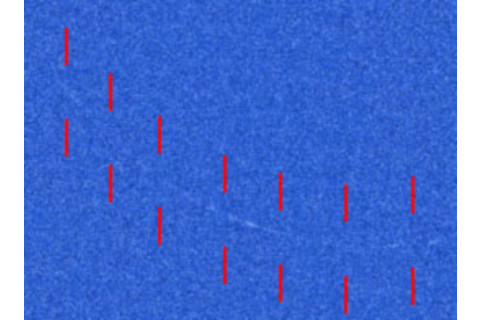
thierrylegault_newmoon_small
It’s actually so tricky to see the Moon this thin that there is an informal competition among astronomers to spot it; it takes a keen eye and some pretty good equipment to see it at all!
In the drawing, the Moon is so close to the Sun that there’s simply no way you’d be able to see it that crisply and cleanly. It would take a telescope at the very least to pick the Moon’s light out from the bright sky, and then you wouldn’t see the other things in the drawing like the Sun or the landscape.
Also, note that off to the right there are stars depicted in the sky! During the day, stars are simply not possible to see in a photograph like this. That’s another alarm bell that this isn’t real.
I got an angle
Another, more subtle, aspect of this drawing is the angle of the Moon, Sun, and horizon. The Moon orbits the Earth while the Earth orbits the Sun, and the way the geometry of these orbits works out makes it so that the path the Moon appears to take across the sky is pretty close to the path the Sun takes. If you were to mark the position of the Sun in the sky every hour or so, and connect them to make an arc across the sky, you’d find the Moon follows roughly the same path*.
However, at the north pole (or up at very high latitudes) the Sun never gets very high above the horizon. The path it takes is low, making a shallow angle with respect to the horizon. And remember, the Moon’s path is similar. Yet, in the drawing, we see the Moon above the Sun, the line connecting them perpendicular to the horizon. In reality, the crescent Moon this close to the Sun would be swung over to the side, and not above the Sun. In the image here, note how the crescent is almost vertical, not horizontal. That’s because at the latitude of the photographer the path of the Moon and Sun in the sky intersects the horizon at a relatively shallow angle. At the north pole, this is far closer to what you’d see as the moon sets. Minus the city lights!
This again shows the drawing isn’t a real photograph.
Hideaway
It’s funny, too: sure, I can point out all the physical characteristics that give away the fact that this isn’t an actual photo… but also, when I look at it, I can just tell it’s not real. It has that feel of a digitally created image; the way the landscape looks, the reflections in the water, the way the sky is so perfectly smooth. Those aren’t really quantitative or physical bits of evidence, but I’ve learned to trust my senses when I see something that my instincts tell me isn’t real, and to look into it further. Sometimes that instinct is wrong, of course, which is why I don’t just jump to a conclusion based on it! But it’s a good way to start an investigation. Call it my spidey sense.
But in this case we do have more to go on! The comparative sizes of the Moon and Sun, the angle between them, the clarity of the lunar crescent: they all point to this being a clever and lovely drawing, and not a photo of a boreal scene. It’s also clear, from Ms. Nielsen’s site hosting the drawing, that she never intended it to be thought of that way; she has a caption which (translated from German) says, “A place you can escape to, if times get too stressful…”. That makes me think this is supposed to be an alien landscape, a large, nearby moon as seen from a terrestrial planet orbiting another star, someplace light years away.
I love work like this (my friend Dan Durda is another gifted space artist)! It shows us places we cannot yet visit, places we cannot yet see, and shows us what they might look like were we to stand there. It inspires us, lifts us, and sparks our imagination.
And the best part? A place like this might actually exist! While we can never see something like this on Earth, there’s no physical reason why another planet couldn’t have something similar to this sight draped across its sky once every month, as its moon and star near each other in the sky (assuming the moon is icy, making it more reflective and easier to see than our own Moon). There are almost certainly hundreds of billions of planets in our galaxy alone, and if even a tiny fraction of them are like our own world, there could hundreds of millions of Earth-like planets out there in the black. Moons are common, too, and water is everywhere. And if the planet is near some very luminous stars, they might be visible even during the daytime. The basic ingredients for this scene exist in our galaxy, and probably in abundance.
Sometimes, life really does imitate art. When that art is based on science, all we just need to do is keep looking, and eventually we’ll find the reality to match it.
Credits: Hideaway: Inga Nielsen; eclipse: Graham Parker; thin Moon: Thierry Legault; Moon set: Ed Yourdon.







